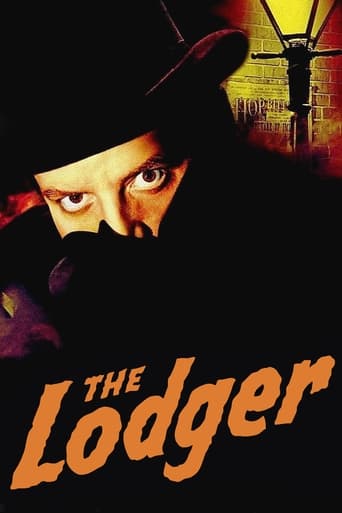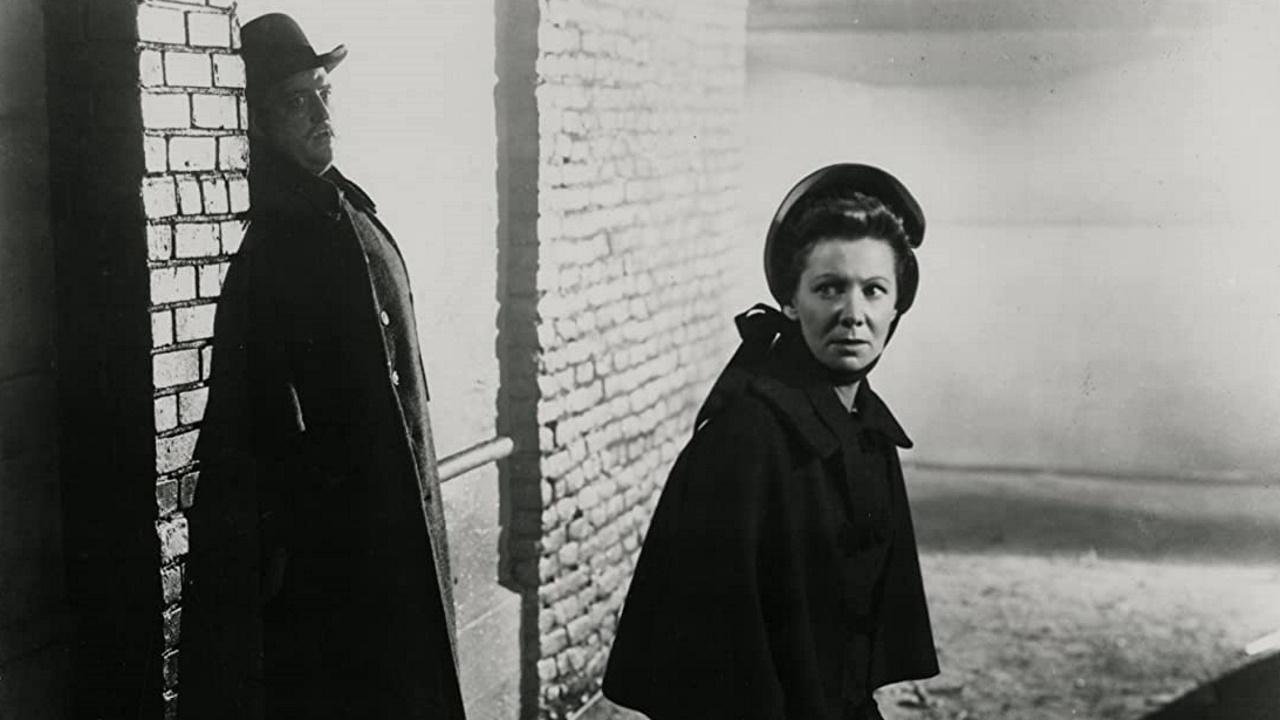Scott LeBrun
Adapting the novel by Marie Belloc Lowndes, 17 years after Hitchcock had done so well with his silent film version, director John Brahm here creates a literate, exciting, spooky Victorian era thriller. During the time of Jack the Rippers' bloody reign of terror, a man who identifies himself as "Slade" (Laird Cregar) rents some rooms from an older couple named the Bontings (Cedric Hardwicke, Sara Allgood). He keeps odd hours, and supposedly needs the space to perform some sort of "experiments". Ellen Bonting (Allgood) comes to suspect that this eccentric gentleman "Slade" might in fact be The Ripper. This new tenant soon develops a fixation on Saras' comely niece Kitty Langley (Merle Oberon), a musical performer.The cast is tremendously good in this kind of setting, and the story, as told by screenwriter Barre Lyndon and director Brahm, is efficient and entertaining. It moves along quite well - even though it gives Oberon an opportunity to strut her stuff in two numbers, these are over fairly quickly. Lyndons' script has some noticeable themes to it, such as the cleansing power of water, and of the supposed "evil" that can be found in the most beautiful of women. The sets, the costumes, and the superior black & white cinematography by the talented Lucien Ballard all add substantial value to the production. It's as wonderfully atmospheric as so many other b & w horror films from the 30s and 40s. Some of the best moments actually take place when the score cuts out and we're left with ambient sound on the soundtrack. Brahm was one filmmaker who really knew how to generate suspense.Cregar is excellent in the title role. Even though we're never in any real doubt as to "Slade"s' identity, he dares to invite some sympathy for this deluded, deranged character. He makes all of his scenes riveting. Oberon is enticing as the young woman who will become his object of desire. The dapper, elegant George Sanders is fun as the Scotland Yard detective in charge of the case. Hardwicke and Allgood are fine as the landlords, and he's the one who urges some calm and reason while her imagination starts going wild. Aubrey Mather, Queenie Leonard, Doris Lloyd, David Clyde, Helena Pickard, and Frederic Worlock are all fine in support.Well worth a look, especially if one is partial to the genre films of this era, and / or they have a fascination for any Ripper-related story.Same story filmed again nine years later as "Man in the Attic", with Jack Palance in the lead.Eight out of 10.
Coventry
Everybody in this world loves enigmas
The best example to prove this remains the unsolved mystery surrounding the Jack the Ripper murders in London at the end of the 19th century. For more than 125 years now, Jack the Ripper has been the source of inspiration for numerous of films, TV-shows, documentaries and novels. Whether based on facts or purely fictionalized, the notorious serial killer continuously remained a relevant and popular horror/thriller protagonist. In 1913, Marie Belloc-Lowndes wrote her novel "The Lodger" and even though her story was mainly pure fiction, the book nevertheless became one of the most prominent Jack the Ripper sagas and got adapted into at least five film scenarios already. In 1927 the book formed the inspiration for none other than Alfred Hitchcock's first steps in the cinema industry with "The Lodger: A Story of the London Fog", and in 1953 the booked help launching Jack Palance's film career with "Man in the Attic". The personal favorite version of yours truly, however, is the stunningly atmospheric and compelling 1944 version directed by the German immigrant director John Brahm and starring the charismatic Laird Cregar as the suspicious and overly introvert lodger Mr. Slade who may or may not be maniac responsible for the gruesome Ripper murders in Whitechapel. Almost every aspect about "The Lodger" is impeccable and everyone's contribution is equally important. Belloc-Lowndes' source novel narrates the story from a different and fascinating angle. While the entire city of London lives in fear because of the gruesome murders of actresses and/or showgirls, Robert and Ellen Bonting receive a new lodger for their extra room and attic in the shape of the courteous but somewhat distant Mr. Slade. He warns them that he often has to go out during the night and that he uses the attic to conduct medical experiments, but the elderly couple still attempts to connect with him. When Mr. Slade meets their lovely niece Kitty, he increasingly grows fond of her even though she's a stage actress
And Mr. Slade firmly believes that all stage actresses are putrid and on a mission to disrupt the lives of noble gentlemen! As stated above, everyone in this production contributed to the success of the film! Director John Brahm is of German descent, and thus he clearly brought the beautiful influences of silent expressionist masterpieces with him. Cinematographer Lucien Ballard stuffs the film with countless of grandiose camera angles and manages to make the fogbound city look even more menacing than she already is. The supportive cast includes a handful of fantastic names and they each deliver great performances, like George Sanders ("The Picture of Dorian Gray") as the intelligent constable, Merle Oberon ("Wuthering Heights") as the naive but beautiful and sweet object of obsession and Sir Cedric Hardwicke as the ranting newspaper-addicted estate owner. However, they all remain in the shadow – pun intended – of Laird Cregar who depicts his character so good that it's nearly indescribable! Mr. Slade is menacing and simultaneously pitiable, sophisticated as well as primitive and generally speaking just overwhelming to observe! According to news articles that I've read, Cregar struggled with many complexes, regarding his appearance as well as his homosexuality, and the disunity of his own persona definitely reflects here on screen. He wanted to avoid further typecasting and thus went on an extreme and unsupervised diet which cost him his life at the tragically young age of 28. "The Lodger" and another magnificent collaboration with John Brahm called "Hangover Square" were the final achievements of an actor that easily could have become legendary if only he had lived a little bit longer
And, last but not least, another powerful contributor to the success of "The Lodger" is definitely its time of release! The aforementioned Hitchcock adaptation perhaps came too soon and "Man in the Attic" perhaps came too late, but this version got released during a footnote revolution in the horror movie industry. In the 1930s, Universal dominated the horror business with their grotesque monsters like mummies, werewolves, vampires and Frankenstein creatures. In the early 1940s, on the other hand, producer Val Lewton and RKO Pictures started making eerie and atmospheric horror movies that gave human faces to the monsters. Suddenly evil didn't have fangs or fur anymore, but instead it had penetrating dark eyes and wore stylish suits. Cregar's Mr. Slade perfectly belongs in this horror evolution and easily ranks as one of the most memorable creeps of the decade. Admittedly "The Lodger" also has a few defaults. Mr. Slade often behaves a bit too suspiciously and nervous even though Jack the Ripper is supposed to be cold-blooded and professional, while the naivety of Kitty and the ignorance of Robert Bonting are exaggeratedly implausible. Still, it's a tremendously brilliant film from start to finish, with a breathtaking finale to boot!
The_Void
The Lodger has been made several times since Alfred Hitchcock directed the original in 1927; and this is the second of the remakes. It's difficult to compare this film to the original as they're fundamentally very different; owing to the fact, of course, that the original was a silent picture and this one has sound. I will, however, say that Alfred Hitchcock's film is the more effective telling of the story and this one has a number of problems, mostly owing to the characters central to the story. The plot is very simple. The scene is set in London during the time of Jack the Ripper. Around the time he's tearing his way through the women of the city, a landlady and landlord have taken in a lodger named Mr Slade. He's a very strange man; a sinister misdemeanour and the fact that he likes to go out walking for seemingly no reason in the middle of the night being just the tip of the iceberg. Naturally, it's not long before Mr Slade's behaviour is likened to Jack the Ripper and his landlady begins to suspect that he's the killer.All the main characters in this film are far too over the top. Laird Cregar takes the role of the lodger; and while it's undoubtedly a commanding and captivating performance, he's simply too sinister and weird, (not to mention not very good at covering his tracks) and wouldn't have been more suspect if he actually had "Jack the Ripper" tattooed on his forehead. By contrast, his landlords; played by Cedric Hardwicke and Sara Allgood are two of the slowest individuals to grace cinema. Sure they get an inkling of their lodger's true identity fairly early on; but it takes them a long time to come to an all too obvious conclusion. All this stuff really brought the film down for me; but rating purely in terms of cinema, The Lodger fares a little better. Director John Brahm expertly captures the underbelly of London and the film has a really great atmosphere. Naturally, the film is not graphic; but we do get treated to a few unsettling murder scenes also. Overall, I do have to say that I enjoyed this film in spite of my problems with the characters and would rate it as worth seeing.
rose-294
Based on the 1912 novel by Marie Belloc Lowndes (expanded from her short story), this third and best version of Lodger easily beats the earlier efforts - yes, including the silent film directed by Alfred Hitchcock. The lushly produced, atmospheric film, written by play-writer Barre Lyndon, produced by Darryll F. "Gone with the wind" Zanuck and directed by German-born John (Hans) Brahm, Fox's 1944 Lodger is excellent Gaslight Gothic. It is set in fascinating, romantic milieu that unfortunately existed only in the movies - 1940's Hollywood version of Victorian London, complete with the opulent interiors, black and white photography, clean streets and clean-mouthed, literate dialogue, stalked by the murderer who is now called Jack the Ripper (not the Avenger, like in the novel and earlier film versions). Laird Cregar is sexually troubled lodger suspected as dirty deeds and despite his hate toward women, he is sympathetic just as the poor "actresses" he kills - more a troubled, tortured soul than your everyday sleazy misogynist. Merle Oberon is the pure and pretty heroine, a dance-hall actress and can can dancer, and George Sanders is the Scotland Yard detective. A classic.


 AD
AD

